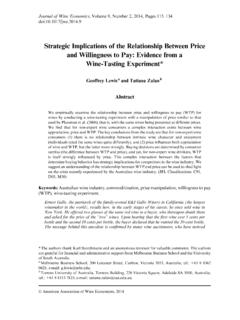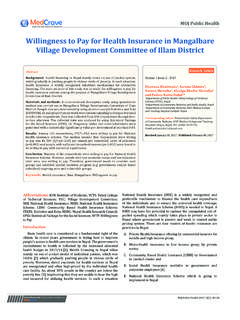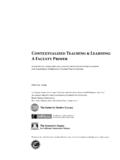Transcription of The Influence of Attitudes and Affect on Willingness to ...
1 The Influence of Attitudes and Affect onWillingness to communicate and SecondLanguage CommunicationTomoko YashimaKansai UniversityLori Zenuk-NishideKyoto Gaidai Nishi High SchoolKazuaki ShimizuKansai UniversityThis article investigates results and antecedents ofwillingness to communicate (WTC) in a second language (L2) through 2 separate investigations conducted withJapanese adolescent learners of English. In the firstinvestigation, involving 160 students, a model wasTomoko Yashima, Institute of Foreign language Education and Research;Lori Zenuk-Nishide, Course of International and Cultural Studies; KazuakiShimizu, Department of Psychology, Faculty of research was partially supported by a research grant fromKansai University during 2001 and 2002. An earlier version of this articlewas presented under the titleInfluence of Attitudes and Affect on L2 communication : A Study of Japanese High School Studentsat the 13thWorld Congress of Applied Linguistics in Singapore on December 17, would like to thank Peter MacIntyre for letting us use thecommunication-related scales that he adapted from McCroskey andRichmond (1991) to refer to second language as well as for his valuablesuggestions, and Linda Viswat for her valuable comments.
2 We would alsolike to express our gratitude to anonymous reviewers for their very helpfulsuggestions on an earlier version of this concerning this article should be addressed to TomokoYashima, Institute of Foreign language Education and Research, KansaiUniversity, 3-3-35, Yamate-cho, Suita-shi, Osaka, Japan. Learning54:1, March 2004, pp. 119 152created based on the hypothesis that WTC results inmore frequent communication in the L2 and that theattitudinal constructinternational postureleads to WTCand communication behavior. This model was tested withstructural equation modeling and was found to fit thedata well. The second investigation with 60 studentswho participated in a study-abroad program in theUnited States confirmed the results of the first. Finally,frequency of communication was shown to correlate withsatisfaction in interpersonal relationships during goal of second language (L2) and foreign language (FL)learning is to facilitate better communication and understandingbetween individuals who come from different cultural back-grounds and speak different languages.
3 MacIntyre, Cle ment,Do rnyei, and Noels (1998) emphasized communicative goalsusing the conceptual model of Willingness to communicate (WTC), in which L2 proficiency is not regarded as the goal oflearning an L2 per se but is seen as a means to achieve inter-personal/intercultural goals. Both state and trait variables,including self-confidence, intergroup motivation, intergroup atti-tudes, and personality, were shown to Affect one s WTC in the L2in a given of Willingness to communicate in an L2 in the JapaneseContext of English as a Foreign LanguageWhy does this model have relevance in the Japanese con-text of English as a foreign language (EFL), in which dailyinteraction with speakers of English is limited? English is impor-tant as a school subject in Japan, particularly as it is a subjectcovered in entrance examinations to higher education, and thistends to determine the content of programs offered in junior andsenior high schools (see Gorsuch, 2000).
4 Recently, teachers seemto be caught between society s demand for improving practical120 language LearningVol. 54, No. 1communicative skills, on the one hand, and pressure to preparestudents for entrance examinations, on the other, which man-dates a continued focus on grammar/translation. Many Japaneseadolescents, preoccupied with preparing for entrance exams tohigher education, concentrate on raising test scores by memoriz-ing vocabulary/idiomatic expressions and practicing sentencetranslation. These activities are of some value for improving L2proficiency, but under these circumstances, communicatingwith people in the world as a goal of EFL may seem somewhatunrealistic. On the other hand, an increasing number of highschool students participate in study-abroad programs and inten-sive English courses often targeted toward learning to commu-nicate in English.
5 The growing interest in these programsindicates that many students perceive a need to acquire compe-tency in English as a means of international phenomenon, in light of past research on Japanese EFLlearners orientations (reasons to study English; Kimura,Nakata, & Okumura, 2001; Yashima, 2000), seems to suggestthat Japanese youth typically have dual orientations in studyingEnglish: a short-term realistic goal related to examinations andgrades, and a somewhat vague long-term objective related tousing English for international/intercultural a series of studies conducted with Japanese high schoolstudents who sojourned in the United States for the purpose ofstudying English and experiencing a different culture, partici-pants identified, in semistructured interviews and open-endedquestionnaires, taking initiative to communicate with Ameri-can classmates or host families and being open and sharingone s feelings/thoughts as important behavioral repertoires thathelped them to attain satisfaction in their sojourn experience(Yashima, 2002b; Yashima & Tanaka, 1996, 2001; Yashima &Viswat, 1993).
6 Many students found it particularly vital, thoughdifficult, to initiate interactions and make friends at school. Onestudent s comment in an interview illustrates students percep-tion (see Yashima, 2002b, for more examples): If I m quiet inJapan, my friend will talk to me and say, What happened? ButYashima, Zenuk-Nishide, and Shimizu121here they will think She is quiet, so she doesn t want to speak tous. So I ve got to talk to them. Many students stated that whatthey wanted to change in their behavior was to take initiative intalking to people at school instead of waiting for someone to talkto them, which did not happen as often as they had expected. Wemight say that although many students had the desire to inter-act with their hosts, they were not quite ready to communicatebecause of a multitude of factors, including state L2 use anxietyand perceived lack of L2 competence, as in MacIntyre s (1994)model of WTC.
7 In some cases a vicious cycle was generated:Students need to communicate with host nationals to improvetheir communicative competence and gain confidence in usingthe L2, but since they do not have confidence, they cannot createopportunities by initiating variables, such as when and where the interac-tion takes place, who the communication partner is, and who ispresent in the situation, do indeed Affect how willing one is tocommunicate in a given situation. It was demonstrated inYashima (2002b) that the receptivity of host family membershas a supporting function. Some students reported that withthe help of accommodating hosts who tried to involve studentsin interactions, they could open themselves up and achievesatisfaction in human relationships. Host families serve as guardians to students by taking on the responsibility of provid-ing support.
8 To make friends at school, however, students haveto build interpersonal relationships by themselves using thelanguage they are trying to learn. The students need to workhard to secure their places in the new environment. From an L2teaching/learning perspective, it is hoped that the studentsacquire the necessary skills and WTC to change the dynamismof interaction by themselves rather than leaving it to the empa-thy/control of partners in intercultural improve communicative skills one needs to use lan-guage. This is specifically why WTC is potentially of great impor-tance in the Japanese EFL context, if to improve the practicalcommunication skills is to be a goal of English teaching, and122 language LearningVol. 54, No. 1also if one believes that communication with dissimilar others (Ting-Toomey, 1999) is in L2 WTCA lthough the negative effect of language anxiety on L2language acquisition has been widely studied (Gardner &MacIntyre, 1993; Horwitz, Horwitz, & Cope, 1986; MacIntyre& Gardner, 1991, 1994), studies in WTC originated in commu-nication research in the United States.
9 communication appre-hension in a first language (L1) and its negative Influence oncommunication have been largely a matter of scholarly atten-tion by communication researchers (Daly & McCroskey, 1984;McCroskey, 1977). McCroskey and associates (McCroskey, 1992;McCroskey & Richmond, 1987, 1991) proposed the constructWTC, which captures the implications that communicationapprehension, introversion, reticence, and shyness have for com-municative behavior. MacIntyre (1994) developed a path modelthat postulates that WTC is based on a combination of greaterperceived communicative competence and a lower level of com-munication anxiety, then applied the model to L2 communica-tion. Studies conducted in various Canadian contexts combinedthe WTC model with Gardner s (1985) socioeducational model toexamine the relations among variables underlying WTC in theL2.
10 In the socioeducational model,integrativenessrefers to thedesire to learn an L2 to meet and communicate with members ofthe L2 community. It is expected that students with a higherlevel of integrativeness and stronger L2 learning motivation willmore readily interact with an L2 language group than those witha lower level of integrativeness and motivation. MacIntyre andCle ment (1996) showed that in a monolingual context in Canada,motivation influenced WTC in the L2, which, in turn, resulted inincreased frequency of L2 communication . In studies conductedin various ethnolinguistic contexts, WTC was a predictor offrequency of communication in the L2, whereas motivation wasYashima, Zenuk-Nishide, and Shimizu123a predictor of WTC, frequency of communication , or both(MacIntyre & Charos, 1996; MacIntyre & Cle ment, 1996).L2 WTC is not regarded as a simple manifestation of L1 WTC, which is more a personality trait, since a much greaterrange of communicative competence is evident in an L2 than inan L1, and L2 communication carries a number of intergroupissues, social and political implications that are usually not assalient in L1 use (MacIntyre et al.)








